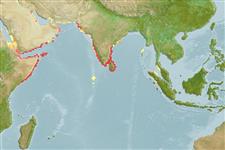Elasmobranchi (squali e razze) (sharks and rays) >
Myliobatiformes (Stingrays) >
Dasyatidae (Stingrays) > Urogymninae
Etymology: bineeshi: Named for Indian biologist K.K. Bineesh..
Environment: milieu / climate zone / depth range / distribution range
Ecologia
marino demersale; distribuzione batimetrica 13 - 22 m (Ref. 110187). Tropical
Indian Ocean: Pakistan and India, Bay of Bengal; probably most widely distributed but its occurrence may be strongly habitat dependent.
Size / Peso / Age
Maturity: Lm ? range ? - ? cm
Max length : 66.0 cm WD maschio/sesso non determinato; (Ref. 110187); 25.0 cm WD (female)
Short description
Morfologia | Morfometria
Vertebre: 108 - 114. This species (size at least 66 cm DW) is distinguished by the following set of characters: disc is weakly rhomboidal to suboval, its length 93-98% DW; snout is moderately elongate with weak apical lobe, snout angle 116-121°; pectoral-fin apices are broadly rounded; orbits small to medium-sized, barely protruding; relatively narrow mouth, its width 1.2-1.3 in internasal width; distance between first gill slits is 2.2-2.5 times internasal distance; distance between fifth gill slits is 1.4-1.6 times internasal distance, 28-30% of ventral head length; pelvic-fin base is broad, 14-15% DW; main suprascapular denticle is large, yellowish, broadly ovate, usually followed by smaller subtriangular denticle; secondary denticles developing rapidly, forming a broad band extending from interorbit to tail base by 24 cm DW; dorsal disc uniformly light brown, without white spots; pale ventrally with broad, faint and slightly darker lateral margins; tail dark brown to blackish dorsally and white ventrally forward of caudal sting; plain blackish posteriorly or with weak, irregular pale dorsal banding (in young); pectoral-fin radials 127-131; total vertebral count, 108-114, including synarcual centra, monospondylous centra 44-46, pre-sting diplospondylous centra 64-69 (Ref. 110187).
Smallest specimen, immature male at 20 cm WD is postnatal; birth size unknown, but probably ca. 15.0-17.0 cm WD (Ref. 110187).
Life cycle and mating behavior
Maturità | Riproduzione | Deposizione | Uova | Fecundity | Larve
Manjaji-Matsumoto, B.M. and P.R. Last, 2016. Two new whiprays, Maculabatis arabica sp. nov. and M. bineeshi sp. nov. (Myliobatiformes: Dasyatidae), from the northern Indian Ocean. Zootaxa 4144(3):335-353. (Ref. 110187)
IUCN Red List Status (Ref. 130435)
Warning: mysqli::__construct(): (HY000/1040): Too many connections in /var/www/html/includes/func_getlabel.php on line 46
Can't connect to MySQL database (fbapp). Errorcode: Too many connections
